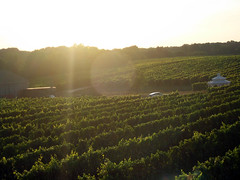
Pellegrini Evolution
Determining a wine's lifespan is one of the most theoretical speculations a critic can make. Granted, one can refer to historical tastings (ie: Bordeaux) and use comparable vintage conditions, or use the open bottle test to see how the wine handles oxygen exposure. How can one possibly define the lifespan of a wine that is produced from a region that is still in it's infancy from an enological perspective? I guess the short answer is conservatively. 'When to drink' windows should be modest and cautious, unless you have substantial evidence to suggest otherwise. I like to put theory and caution up to the test, so here lays my experiment: A 1997 Pellegrini Merlot. It's been nearly a decade since the grapes were harvested in the budding wine region of Long Island's North Fork. Although the vineyards of Pellegrini are some of the oldest on the island, they are most likely dominated by vines w/ years in the single digits. Although this region is not marked by maturity, it is definitely defined w/ potential. The terroir of Pellegrini's vineyard is imbued w/ well-drained loam soils adjacent to the moderating maritime effects of the Atlantic. In 2000, the Wine Spectator reviewed the 'exuberantly fruity' Merlot with an outstanding 90 point score. Seven years later, I'm interested in how this Long Island Merlot has progressed.
The perfect place to experiment w/ the aged NY Merlot was in an up and coming restaurant called the Lamb and Jaffy. A relatively new venture began by caterers; Jaffy offers an adventurously eclectic mixture of New Age American fare, w/ a nice spin on some old stand-by dishes like pan charred flank steak and spicy tilapia. This little gem is a perfect addition to the budding Polish neighborhood of Greenpoint, Brooklyn (which also happens to be the town where I currently hang my hat). Considering that the proprietors have chosen not to apply for an expensive liquor license, I can't help but take advantage by bringing my own booze.
Oh, and the wine you ask? After the cork was popped and the inky purple merlot splashed into my glass, heady aromas of Long Island loam filled the air. I found the nose to be quite pronounced, filled w/ spicy red peppers, olive paste and fresh mushroom. I considered it to be a bouquet of secondary bottle age, w/ more mature scents of earthy terroir, marked by nice depth that seemed to zip through my nostrils. There was quite a bit of mid palette flesh marked by juicy blackberry, dried cherry and allspice. Medium to full bodied, w/ tea herb and ripe fruit on the medium finish. Not only did the wine gain complexity and nuance, the fleshy fruit seemed to meld into a deeper, more mature flavor. Granted it was a non-blind dinner tasting, (coupled by a lovely medium-well lamb burger I might add) but I believe my commentary and evaluation should still have some credence. As objectively as possible, I score the '97 Pellegrini Merlot 89 points, a hair shy of outstanding (which may have moved to outstanding if I were in a more controlled environment).
Not only has the wine sustained nearly 10 years, it has evolved quite nicely w/ Bordeaux-esque hallmarks of subtlety. I can't help but observe the similarities in composition and stature of the Pellegrini Merlot (and a few other North Fork grown varietals for that matter) and some of the Merlot dominated wines of St. Emillion. By no means I am directly comparing the two from a quality perspective, but take notice to these similar characteristics. Modest alcohol content for both (roughly 13% and change), similar pH make up, emphasis on freshness and balance. Bordeaux and the North Fork are located on the same longitudinal level and they both receive similar amounts of sunshine and rainfall. Temperature averages are similar, and soil composition is at least in the same ballpark for both regions. Clonal selection and wine making aside, when the grapes of Long Island are blessed by Mother Nature (as they were in '97) and they achieve physiologic ripeness, the structure of their wines can be quite similar to that of Right Bank Bordeaux.
The jury is still out on exactly how wines age, but it is believed that the interplay of tannin (a preservative) and acid shape the wine's evolution and structure. The aging process of Bordeaux has been extensively studied, as well as documented, but the New World babies’ progression to adulthood is still an enigma. First and foremost, why wait? Most taste good upon release (which our impatient consumers demand) and who would cellar a wine they believe is ready to drink? Not an American! French have historically criticized the open, accessible and fruit-forward west coast wines to be incapable of longevity (they also feared that the 1982 vintage in Bordeaux would fall apart after a few years and it seems Mr. Parker has proved them wrong). Super-ripe California wines have been shown to sustain, but seem to have too much muscle for any secondary subtlety to be noticed.
Now Long Island on the other hand, who knows? With some exceptions, their production isn't sizeable enough for lofty storage of past vintages. The region itself is chock full of young vines and even younger vintners that are progressing at a dramatically fast rate. It's great to see the passion, altruism and excitement of an up and coming wine destination. If I were old enough, I may even say that it reminds me of the unbrideled youth of the California wine boom of the 70's. Who knows....I don't expect one amateur wine review of a region still in it's infancy to ruffle too many cuffs, but it is a great place to start.












0 Comments:
Post a Comment
<< Home